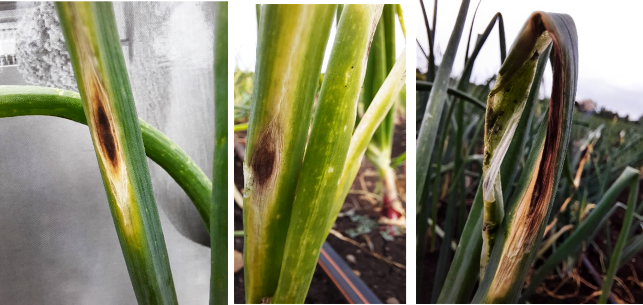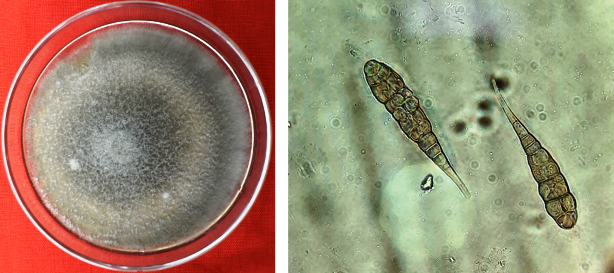प्याज उत्पादकों के लिए बड़ा खतरा जांभळा करपा या बैंगनी धब्बा रोग
Onion is susceptible to numerous foliar, bulb and root pathogens that reduces the quality and yield. Among the pathogens Alternaria porri, which causes purple blotch disease of onion is a serious menace in onion producing countries of the world. Found in all places where onions and garlic grow.
The disease is also known as leaf spot or blight disease of onion and is the most destructive disease during kharif and rabi and drastically reduces the yield by upto 97%. The intensity of the diseases varies from season to season, variety to variety, and region to region.
Symptoms:
In this disease, initially small, suppressed, oval spots on the leaves which turn mostly purple-brown in colour. These spots gradually increase and initially purple spots later turn black. The leaves fall due to the wound. The lesion starts from the upper part of the old leaves. Plants become soft and weak from the neck. The flower stems also twist and fall. This disease can cause 50 to 70 percent damage.
 Symptoms of Purple blotch
Symptoms of Purple blotch
 Colony and conidial morphology of Alternaria Porri
Colony and conidial morphology of Alternaria Porri
Disease cycle and favourable conditions:
The disease is more prone to outbreak in Kharif season. Normally 18 to 20°C. Temperature and more than 80 percent humidity, frequent rain and dews and prolonged leaf wetness (12 hours or more) help in increasing the disease.
The intensity of this disease can be more in Rabi season due to rain in January-February and cloudy environment in the sky. In the late Kharif season crop also, this disease is affected in favorable environment.
Infected plant debris containing pathogen fruiting body with conidia in the farm field or nearby farm is the primary source of inoculum for succeeding bulb crop followed by seed crop of onion, fungus remain as mycelium in onion leaf debris from diseased plants, it does spread by the punctures made by thrips, opening of stomata pores and epidermal layers.
The fruiting body with conidia of leaf lesions fabricated as principal source of inoculum for infections and for disseminating the disease. The frequent wind blows and rain splashes disperse the conidia and mycelium among the stalks and leaves of plants are the secondary source of inoculums.
The pathogen prolong their existence on leaves, seed stalks and on soil surface, hence burring of diseased debris in the soil about 2 to 6 inches deep below the soil soil surface, thus lead to the complete knock out of pathogen by breaking on existence of primary source of inoculum.
Management:
Prevention is difficult when the disease enters the field. Therefore, care should be taken from the very beginning that there is no disease outbreak in the field.
- For soil treatment, Trichoderma cultured should be added to the manure in the field.
- The location of the nursery should be changed every year. Seeds should be sown thin in the nursery.
- Before sowing the seed should be treated with Tebuconazole fungicide.
- Before transplanting, the roots of plants should be treated with Chlorothalonil or Thiophanate methyl or Mancozeb's solution at the rate of 2 grams per liter for 2 hours.
- Trichoderma cultured in manure should be applied again after 40-45 days.
- Weeding and hoeing should be done as per the requirement of the plants.
- Cultivation of onion should be done in kharif season in well drained land and should be planted on raised beds on rams.
- Spray 30 grams of Captan, Benomyl or Mancozeb after washing it in 10 liters of water and spraying it with stickers (adhesive material) at an interval of 12 to 15 days alternately.
- Nitrogenous fertilizers should not be used more than proof and late.
- Proper crop rotation should be adopted. Along with onions, cereal crops should be included in the crop rotation.
Authors:
Jayalakshmi K1., Ram Dutta1., Sharath N1 and Saranya R2
1Scientist (Plant Pathology), 2Principal Scientist (Plant Pathology), 3Young Professional-II, 4Scientist (Plant Pathology)
1,2,3ICAR - Directorate of Onion Garlic Research, Rajgurunagar, Pune, Mahrashtra-410505
4ICAR – Central Arid Zone Research Institute (RRS), Jaisalmer, Rajasthan.
1Email:
